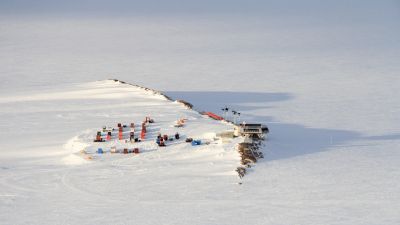
Belgian Antarctic station marks most ambitious season yet
Brussels, 23 March 2012 – Belgium's zero emission Princess Elisabeth Antarctica station recorded its most ambitious Antarctic season to date, attracting more international scientists than ever before, said operators International Polar Foundation today [1].
More than 20 geologists, glaciologists, microbiologists, seismologists and meteorologists from Belgium, Germany, Japan and the US carried out research at Princess Elisabeth during the 2011-2012 Antarctic season, the largest and most logistically demanding seen at the station since operations began in 2008.
"Princess Elisabeth Antarctica's unique location [2] continues to draw top international polar scientists working to increase knowledge and understanding of how our planet works", said Alain Hubert, board director of the International Polar Foundation, on his return from four months at PEA. "Despite operating under a tight budget [2], the station's technical team provided the professional support needed for carrying out scientific research in harsh Antarctic conditions, ensuring that the science teams could work smoothly and safely".
Scientific projects hosted by PEA during the 2011-2012 season included Belgian projects on microbiology, seismology, ozone and Antarctic glaciers [3]. Germany's BGR (Bundesanstalt für Geowissenschaften und Rohstoffe) and the Alfred Wegener Institute for Polar and Marine Research (AWI) concentrated on the geological history of the Gondwana
Supercontinent by studying rock formations in Dronning Maud Land. Japan's NIPR (National Insitute for Polar Research) carried out a geological survey of the Sør Rondane Mountains [4].
The range and scope of this season's projects required intensive logistics operations including the construction of an ice runway, construction of mobile units for the German team in the field, helicopter operations, and the unloading of 240 tonnes of cargo from the station's supply ship in just 24 hours, after the vessel had spent several days trapped in the Antarctic ice pack [5].
In addition to field operations, the Princess Elisabeth crew also carried our further development of the Antarctic station's energy efficent zero emission systems, upgrading to higher capacity storage batteries, with an estimated 25% increase in capacity [6].
"With the success of renewable energy and energy efficiency at Princess Elisabeth Station, even in the tough Antarctic environment – it's clear that we have a real opportuntity to transfer these ideas into new ways to manage energy use in our homes, workplaces and cities, laying the groundwork for a new era of sustainable development", said Hubert.
The International Polar Foundation communicates and educates on polar science and research as a way to understand key environmental and climate mechanisms.
Contacts
International Polar Foundation media officer Dave Walsh on +32 493 140 966 or press@polarfoundation.org - or main IPF phone: +32 2 543 06 98
Twitter: @polarfoundation and Princess Elisabeth Antarctica @antarcticbase
Notes for Editors:
For more about Princess Elisabeth Antarctica, visit http://www.antarcticstation.org
For more about the International Polar Foundation, visit http://www.polarfoundation.org
[1] The International Polar Foundation is the appointed operator of Princess Antarctica Station for the Belgian Polar Secretariat.
[2] Princess Elisabeth Station is located in the Soar Rondane Mountain Range, Dronning Maud Land, East-Antarctica. The station lies at 71° 57' S and 23° 20' E, 220 km due South from the edge of the ice shelf.
[3] Details on all science projects at Princess Elisabeth in 2011-2012
Belgian research projects:
BELATMOS - Ozone, UV radiation and aerosols - Belgian Royal Meteorological Institute (RMI), Dr. Alexander Mangold
BELISSIMA – understanding ice dynamics – Katherine Leonard (USA), WSL Institute for Snow and Avalanche Research (SLF) in Davos, Switzerland for University of Brussels
BELDIVA – Exploration of microbiology diversity - Dr. Elie Verleyen, Universiteit Gent. Open-top chamber:
GIANT-LISSA - "Geodesy for Ice in ANTarctica" and "Lithospheric and Intraplate Structure and Seismicity in Antarctica" by Dr. Denis Lombardi, Observatoire Royal de Belgique
[4] Germany: Bundesanstalt für Geowissenschaften und Rohstoffe (BGR) and Alfred Wegener Institute (AWI): Investigating Gondwana Formation and Break-up: BGR scientists collected rock samples in the field, assisted by helicopter to reach areas which are difficult and time-consuming to access by ground transport and to work as efficient as possible in the relatively short Antarctic summer. As part of GEA II, AWI and BGR scientists jointly conducted an aerogeophysical survey in the greater area of Sør Rondane on AWI's new Polar 6 aircraft, which was being used to assess gravity and magnetic field anomalies. Magnetic gravity and ice thickness measurements were taken from the coast across the mountains to the polar plateau to give the research team a better picture of the rock formations below the ice. More info is available on the station website and on the project website for this year.
Japan's National Institute for Polar Research (NIPR) goal has been to determine the age of the various rock formations and analyze the movement of glaciers through these rock formations to link it to climate change. Glaciers go through cycles, receding and rising according to temperatures. By examining the rocks through which they pass, and determining whether these rocks were covered or exposed by glacier movements, scientists can track past temperatures and climate.
[5] For more background on the season's logistics at PEA, have a look on our website.
[6] For more stories on development of systems at Princess Elisabeth Antarctica during the 2011-2012 season, please have a look at those articles the station's website
